#Melaleuca Viminalis
Explore tagged Tumblr posts
Text
Melaleuca viminalis
weeping bottlebrush
on macro










0 notes
Text
12 Drought-Resistant Trees In Australia
In the vast, sunbathed landscapes of the Land Down Under, the challenge of cultivating flora that can endure with the help of tree loppers Sydney arid conditions is both an art and a science. This ecological endeavour is not merely about aesthetic landscaping; it's a crucial strategy for sustaining local biodiversity and preserving the natural beauty of the region. As climate patterns continue to evolve, leading to longer and more intense dry spells, the importance of selecting the right species that can thrive in these conditions becomes paramount.
The following guide delves into the trees with the ability to withstand prolonged periods of dry weather. These species are not only survivors but also symbols of the strength and adaptability of the natural world, making them ideal for gardens and landscapes in areas prone to drought. By incorporating these species into our surroundings, we not only enhance the beauty of our environment but also contribute significantly to ecological conservation and resilience in the face of changing climate conditions.
Eucalyptus Gregsoniana
This species, often found in the Blue Mountains, stands out for its robustness in dry conditions. Its narrow leaves and distinct bark make it an excellent choice for water-conservative landscapes.
Brachychiton Acerifolius
Commonly known as the Illawarra Flame, this specimen is celebrated for its spectacular red blossoms. Native to the coastal regions, it's remarkably tolerant to dry spells.
Acacia Pycnantha
Known as the Golden Wattle, this flora is renowned for its vibrant yellow flowers. It's a national symbol of resilience and beauty, thriving in the harshest of climates.
Callistemon Viminalis
Often referred to as the Weeping Bottlebrush, this variety is prized for its unique, brush-like flowers. It is a favourite in gardens for attracting wildlife while requiring minimal hydration.
Angophora Costata
Resembling the more commonly known eucalypts, this species, with its twisted limbs and strikingly smooth bark, is a staple in dry landscapes, offering both shade and aesthetic appeal.
Banksia Integrifolia
The Coastal Banksia is easily recognized by its elongated flower spikes and serrated leaves. It's an iconic coastal species that can survive with very little moisture.
Corymbia Ficifolia
Often termed the Red Flowering Gum, this vibrant flora is a show-stopper with its bright red blossoms. It's a popular choice for adding a splash of colour to arid gardens.
Grevillea Robusta
The Silky Oak is distinguished by its fern-like foliage and golden flowers. This fast-growing species is a favourite among local fauna and requires little water once established.
Melaleuca Quinquenervia
The Broad-leaved Paperbark is known for its papery bark and creamy flowers. It's often found in coastal areas and is highly adaptable to dry conditions.
Allocasuarina Verticillata
Commonly called the Drooping Sheoak, this flora is notable for its needle-like foliage and ability to survive in nutrient-poor soils with minimal water.
Livistona Australis
This palm variety, native to the eastern coastlines, adds a tropical touch to any landscape. Despite its lush appearance, it's surprisingly drought-hardy.
Hakea Laurina
The Pin-cushion Hakea is a unique species with round, pincushion-like flowers. It's a striking addition to any water-wise garden, requiring minimal care.
The cultivation of these drought-resistant species is more than a gardening choice; it's a testament to the resilience and diversity of the natural world. In an era where ecological sustainability is of paramount importance, choosing plants that can endure harsh weather conditions is a step towards a more resilient and environmentally conscious approach to landscaping. These species, each with their unique characteristics and beauty, offer a glimpse into the rich biodiversity of the Land Down Under. They serve not only as a practical solution to the challenges posed by drought but also as a reminder of our responsibility to protect and nurture the environment. In embracing these species, we are not only beautifying our surroundings but also actively participating in the conservation of our planet.
This selection of flora represents a harmonious blend of aesthetic appeal and ecological wisdom, encouraging us to look beyond mere survival and strive for a landscape that flourishes even in the face of adversity. As we integrate these drought-resistant varieties into our gardens and public spaces, we contribute to a legacy of environmental stewardship, ensuring that the natural splendour of our region continues to thrive for generations to come.
Embracing these hardy species in your landscape design not only ensures a vibrant and thriving garden but also contributes to the preservation of the local ecosystem. Each of these specimens brings a unique aesthetic and ecological value, making them ideal for the challenging weather patterns of the region. By choosing these drought-resistant varieties, one can create a beautiful, sustainable environment that resonates with the natural beauty of the Land Down Under.
0 notes
Text
Weeping Bottlebrush pruning
Callistemon uiminalis or Melaleuca viminalis, commonly known as weeping bottle brush.


Today I learnt how to prune and learnt a technique called the crown lift. We gave a bottle brush a kind of haircut, this way we will be able to plant under it and also it looks neater.

The grass (Kikuyu grass, Cenchrus clandestinus / Syn. Pennisetum clandestinum) is blue, as we had sprayed it the day before with Glyphosate, dyed blue to indicate where we've sprayed the chemical.
In this instant Kikuyu grass is seen as a weed and isn’t wanted in the area. Later we'll be planting native grasses.
Another weeping bottle brush, was leaning too far to the left and we cut off the branch, to stop it from eventually snapping off and causing itself damage.
Didn’t get a photo of before, but here’s my drawing of what it looked like.

And the after:

prune pile:

0 notes
Photo
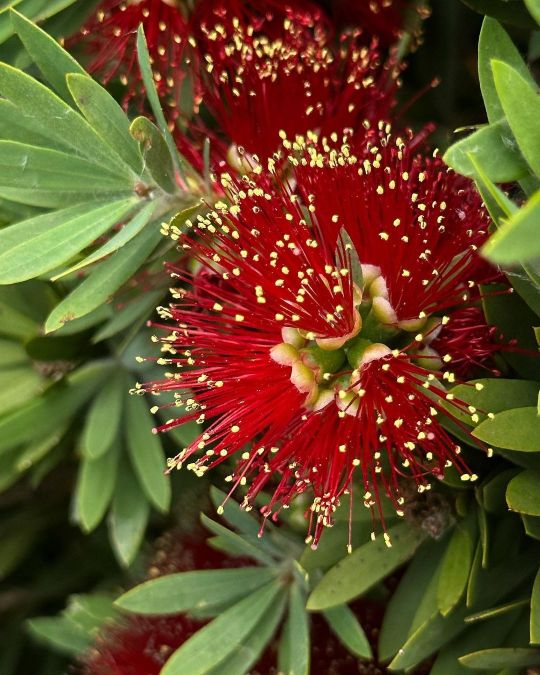
'Little John' Bottlebrush (Callistemon viminalis 'Little John' or Melaleuca viminalis), is a cultivar of what is commonly known as weeping bottlebrush or creek bottlebrush. It's endemic to New South Wales, Queensland and Western Australia. These small bushes are growing in the garden outside Armidale and Uralla Meals on wheels building at the Armidale showground. It's nice to see people putting gardens outside community buildings like these. #Bottlebrush #Callistemon #CallistemonViminalis #LittleJohn #AustralianPlant #bush #flowers #abcmygarden #Melaleuca #MelaleucaViminalis #waterwise (at Belmont, New South Wales, Australia) https://www.instagram.com/p/Cl-meLgOvRD/?igshid=NGJjMDIxMWI=
#bottlebrush#callistemon#callistemonviminalis#littlejohn#australianplant#bush#flowers#abcmygarden#melaleuca#melaleucaviminalis#waterwise
0 notes
Text
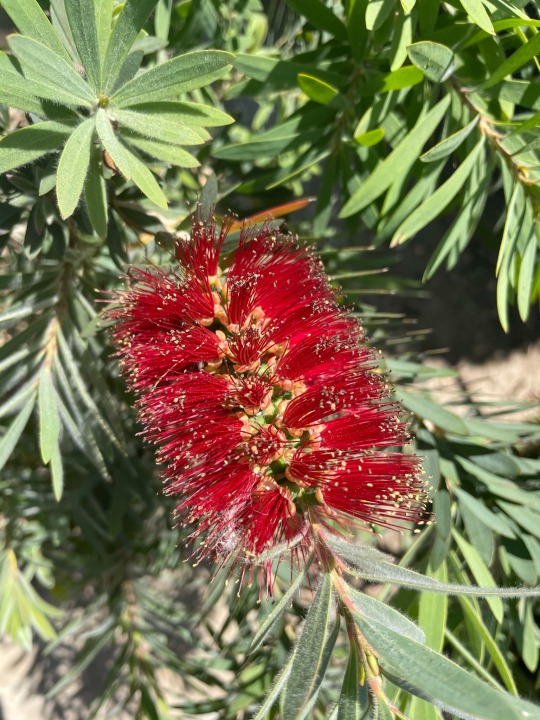
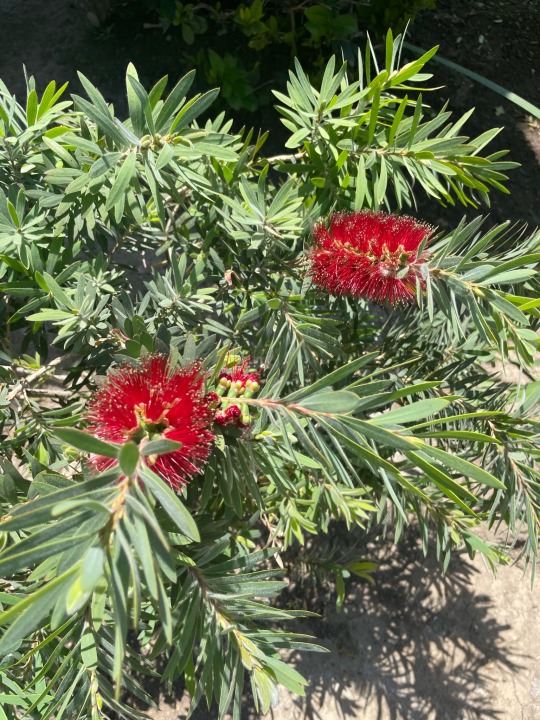
🌺🌸🌼🌻🌺🌸🌼🌻🌺🌸🌼🌻🌺🌸
Day 15.
Today I researched Melaleuca viminalis.
This one was found growing in a residential area of SoCal.
It is commonly known as weeping bottlebrush, or creek bottlebrush. It’s a plant in the myrtle family, Myrtaceae and is endemic to New South Wales, Queensland and Western Australia.
It is a multi-trunked, large shrub or tree with hard bark, often pendulous foliage and large numbers of bright red bottlebrush flowers in spring and summer. It is possibly the most commonly cultivated melaleuca in gardens and its cultivars are often grown in many countries.
Melaleuca viminalis provides food for nectivores. Its adaptations to survive strong currents during flood events allow it to slow the flow of floodwater and reduce erosion, thereby improving the water quality in streams and rivers. The matted roots of this species also strengthen the soil of riverbanks, further reducing the potential for erosion.
🌺🌸🌼🌻🌺🌸🌼🌻🌺🌸🌼🌻🌺🌸
#Melaleuca#Melaleuca Viminalis#Melaleuca Gardens#Bottlebrush#Myrtaceae#Flower#Flowers#Garden#Nature#NaturallyGabakins
4 notes
·
View notes
Text
Melaleuca viminalis- Weeping Bottlebrush

Family: Myrtaceae
Endemic: Australia
Evergreen
Full Sun to Partial Shade
Lives: 40-150 years
Soil: Wet to Dry; sand, clay, loam
Attracts: Birds, Bees
Salt Tolerance: Better inland, moderate on coast

1 note
·
View note
Photo

Melaleuca viminalis - Weeping Bottlebrush Tree
#Melaleuca viminalis#weeping bottlebrush#flower#flowers#tree#red#garden#gardening#plant#plants#planting
3 notes
·
View notes
Text
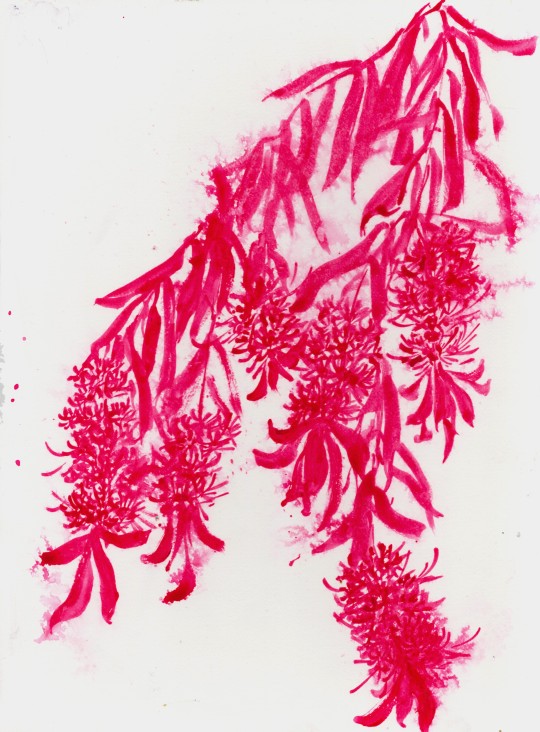
Myrtle Is Having A Party
Watercolor On Artboard
2022, 12"x 16"
Melaleuca viminalis, Weeping Bottlebrush Tree
#art#nature#trees#artwork#artists on tumblr#minimalism#painting#watercolor#floral#flowers#red#red bottlebrush#bottlebrush#weeping bottlebrush#melaleuca#flowering trees#botany#plants
26 notes
·
View notes
Photo



Melaleuca viminalis, also know as Callistemon viminalis
family: myrtaceae
the weeping bottlebrush tree, native to wales and western australia! it’s a popular garden shrub in central and south florida because it can handle the heat and is a huge attraction for pollinators like bees and butterflies. the sticky red brush parts aren’t petals but they’re actually the stamens - the “male” part of the flower containing the pollen.
#mine#botany#plant biology#biology#bottlebrush#plant taxonomy#nomenclature#horticulture#red flower#plant tag
3 notes
·
View notes
Photo

Melaleuca viminalis
Rose beetles really love this friend. 10/10.
#tree#ucsd#wow i thought the last picture sucked#and now look at this#perhaps i am not so good at photography#found on the base level of Mayer
0 notes
Text
That day was quite a gloomy day because it was raining early morning in Perth, but since the tour was a confirmed one, even there was drizzling, I booked an Uber so I can reached the pick-up location which is at the front of Perth City YHA hostel in Wellington Street. At first, I thought that I have to check and asked hostel lobby about the tour, but after I inquired inside, they told me that the pickup was just outside of the hostel. I went outside and had uncertainty about the tour though I was in correct pickup location. I felt that way because I did not see signs such as bus tour or even tour guide nearby. I decided to wait.
There was a car arrived at the parking area of the hostel just beside of the building. Then, a woman came in and then, went out and asked my name. Then, I realized that I was talking to the operator of the tour. She introduced herself to me and her name is Patricia. She explained to me the situation of the tour and told me that she decided to push the tour instead of canceling it, even she just had two visitors for the tour. She told me that there was another guest and we waited a bit inside her car.
The second guest arrived and we were introduced to each other. I forgot her name but I recall she is a Singaporean doing solo travel like myself. After few more minutes passed, when Patricia was ready, we started moving towards the first destination. While we were on the road, I was hoping it’s not raining on places that we will visit that day.
If the first tour that I joined headed south of Perth and the second tour was headed east of Perth, this time, the tour headed north of Perth.
We took Mitchell Freeway, Hester Avenue and Wanneroo Road to reach Yanchep National Park. We parked properly and then walked inside the park. While inside, we went straight towards the Koala Board Walk, where we discussed about Koalas. Patricia mentioned that Koalas was not native animals in Western Australia due to mostly dried weather of the states. And while walking on the board, we found some of Koalas resting in the tree branches. I was able to see again the sleepy head Koala Bears. Even though I had seen Koalas for a couple of times while traveling around Australia, it still great to see them again and again specially if they were sleeping in the tree.


Koalas Board Walk



Some Koalas in the trees
After enjoying Koalas, we explored the park and our tour guide discussed some of the wildflowers and we looked for them, and we found some immediately which just visible at the ground. The first batch of wildflowers that we had seen were : Weeping Bottlebrush and Red-and-Green Kangaroo Paw.


Weeping Bottlebrush / Creek Bottlebrush (Melaleuca Viminalis / Callistemon Viminalis)


Red-and-Green Kangaroo Paw, Mangles Kangaroo Paw or Kurulbrang (Anigozanthos Manglesii)
Our walks continued in Yanchep National Park. While walking casually, the next thing we found was great moment for me. We saw a mother and child western grey kangaroos which I dreamed to see by my naked eyes. Same with Koalas, seeing Roos became a pretty common for me. What’s special about these kangaroos? I wanted to see a mother kangaroo and its young ones called joeys inside the special pouch called marsupium. And that day, I was lucky to see one and able to capture it with my camera.



Female kangaroo carrying joey inside its marsupium (special pouch)
So far for me, the day was nice and great, some wishes that I had has been accomplished. Then, we walked towards Crystal Cave which located at the underground of the national park.
Crystal Cave
When we reached the location of Crystal Cave, there was couple waiting already waiting on the entrance shed. At first, I was wondering where was the entrance of the cave, then I just realized that since its underground cave, the path to the cave is not pretty obvious. While waiting, I read some information displayed in the waiting shed.
This slideshow requires JavaScript.
We waited for few more minutes inside the shed. Then, the cave tour guide and other tourist came out from the ground. Then, he counted the waiting visitors which means that the tour session is open for limited numbers at a time.

We entered the cave through passing a restricted fence and we stepped down the stairs. The moment we were down, I felt the cold weather that circulates at the underground cave.


The first scenery that greeted us the moment we stepped down the stairs from the entrance.

Here we first stopped for a moment while our cave tour guide explaining about the cave. Here, it was mentioned that Henry White whom the first entered the cave in 1903. Then, we took a few steps stairs towards the one of cave chamber.


Water drips from the cave roof to the ground

Chamber where it was emphasized to us some of the formations that can be found in the cave. It was also mentioned here the fauna that lives here. And one of them is stygofauna.


Stalactites

Stygofauna





Stalactites



Stalagmites

Stalactites

Columns (with our cave tour guide)

A sample of water dripping that forms stalactites and the water formed in the ground will result to stalagmites. But these formations cannot be seen immediately at it requires hundred years or more to have even an inch of stalactite or stalagmite.

Some columns


Stalactites



Flowstone





Stalactites and Shawls

Stalactites and Columns

Flowstone



Stalactites

Stalactites with Shawls




Shawls

Flowstone


Stalactites


Stalactites with Shawls

Columns



Columns


Flowstones with Stalactites

Stalactites, Stalagmites and Columns






Flowstones, Columns, Shawls, Stalactites and Stalagmites









Columns, Stalactites and Stalagmites



Fossils






Crystal Cave Photos
After exploring Crystal Cave, before we leave the park, we did a bush walking to see and discover the second batch of wildflowers exists in Yanchep National Park. The following wildflowers found were : One-Leaf Cape Tulip, Bristly Cottonhead, Showy Eremophila, Parrot Bush, Common Smokebush, Milkmaid, One-sided Bottlebrush, Posy Trigger-Plant, Yellow Buttercup, Showy Dryandra, Flame Pea, and Cape Marigold.

One-Leaf Cape Tulip (Moraea Flaccida)

Bristly Cottonhead (Conostylis Setigera)


Showy Eremophila (Eremophila Racemosa)

Parrot Bush (Banksia Sessilis)


Common Smokebush (conospermum stoechadis)

Milkmaid (Burchardia congesta)

One-sided bottlebrush – (Calothamnus quadrifidus)

Posy Trigger-Plant (Stylidium crossocephalum)

Yellow Buttercup (hibbertia hypercoides)


Showy Dryandra (Dryandra formosa)

Flame Pea (Chorizema cordatum)

Arctotheca calendula capeweed, plain treasureflower, cape dandelion, or cape marigold
Other unidentified wildflowers


One more thing that I was fascinated while inside Yanchep National Park, they call it Grass Trees. Literally, they look like just normal grass from the ground at the start but they grow tall as trees.

This slideshow requires JavaScript.
Grass Trees
Before leaving the national park and before the heavy rain fell, I had a chance to enjoy the Yanchep Lake which also called as Loch Mcness.




Loch McNess
That’s how we enjoyed the exploration of Yanchep National Park. Until then.
Notes : 1. Plan to visit Yanchep National Park ? Please check latest information here. 2. Location : Yanchep WA 6035, Australia 3. Directions to the town of Hyden: Transportation : a. Join Day Tours from Perth or b. Drive towards Yanchep WA 6035, Australia or c. Take train (Joondalup Line) from Perth Underground Station, then get off at Butler Station and take taxi to Yanchep National Park or d. Take train (Joondalup Line) from Perth Underground Station, then transfer to Butler Station and take bus to Marmion Avenue After Revolution Avenue, and take taxi to Yanchep National Park Official Website : Yanchep National Park
Yanchep National Park – One of the Oldest Park in Western Australia That day was quite a gloomy day because it was raining early morning in Perth, but since the tour was a confirmed one, even there was drizzling, I booked an Uber so I can reached the pick-up location which is at the front of Perth City YHA hostel in Wellington Street.
0 notes
Text


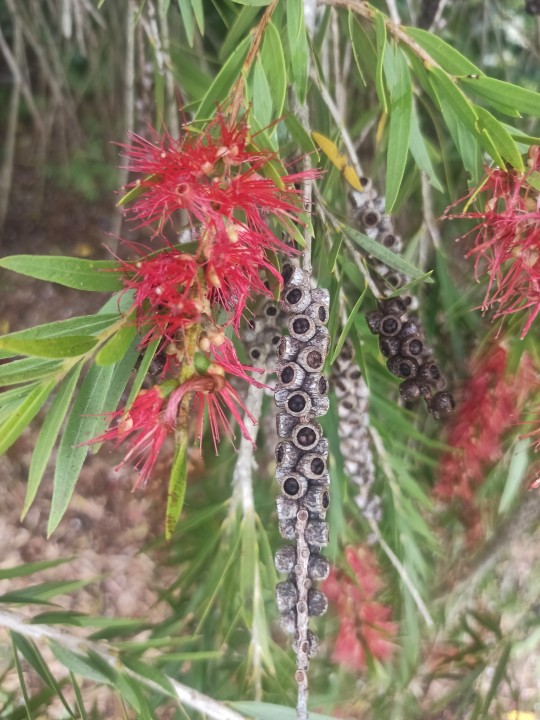

Melaleuca viminalis, commonly known as weeping bottlebrush or creek bottlebrush, is a plant in the myrtle family Myrtaceae, and is endemic to New South Wales, Queensland and Western Australia. (Some Australian state herbaria continue to use the name Callistemon viminalis. The specific epithet (viminalis) means "having long, slender branches".)
Clade:Eudicots
Clade:Rosids
Order:Myrtales
Family:Myrtaceae
Genus:Melaleuca
Каллисте́мон сплетённый, или Красивотычи́ночник сплетённый, или Краснотычи́ночник сплетённый— вид рода Каллистемон семейства Миртовые.
Считается антибактериальным, противогрибковым, глистогонным, кровоостанавливающим, мочегонным средством. Исследования показали антигельминтные, антикворумные, инсектицидные, противоинфекционные, антибактериальные, моллюскоцидные, антиоксидантные, противораковые, противовоспалительные, антиагрегационные свойства.
826a East Coast Road, Oteha, Auckland 0630
7PJC+FWQ Auckland
-36.7187920, 174.7223690
наземные растения, цветковые деревья
25sep2023
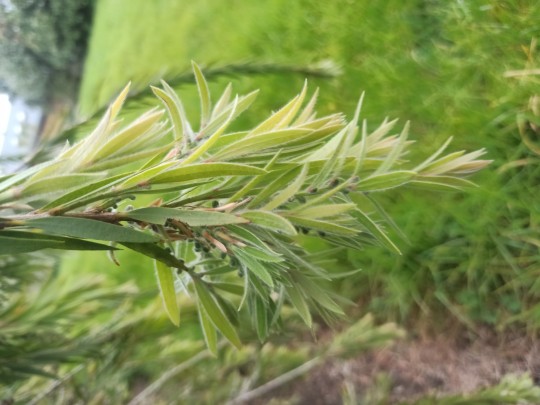
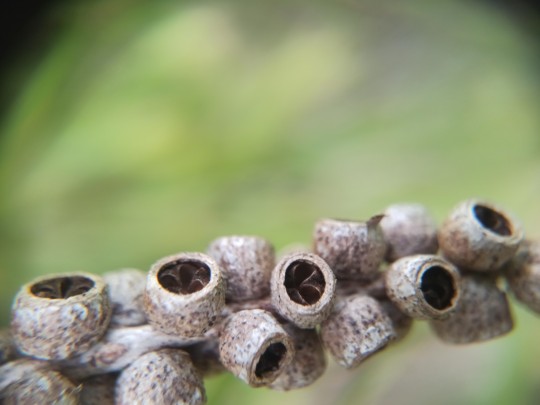

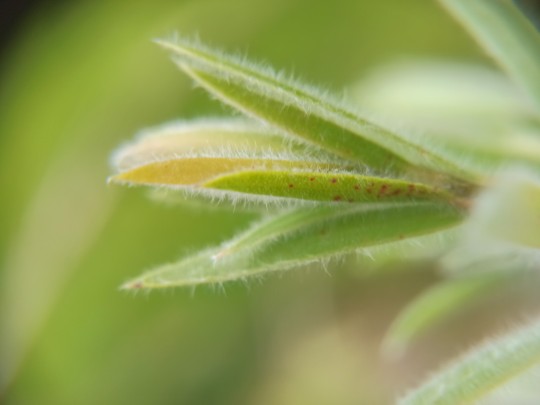


0 notes
Photo

Melaleuca viminalis - Weeping Bottlebrush
0 notes
Text
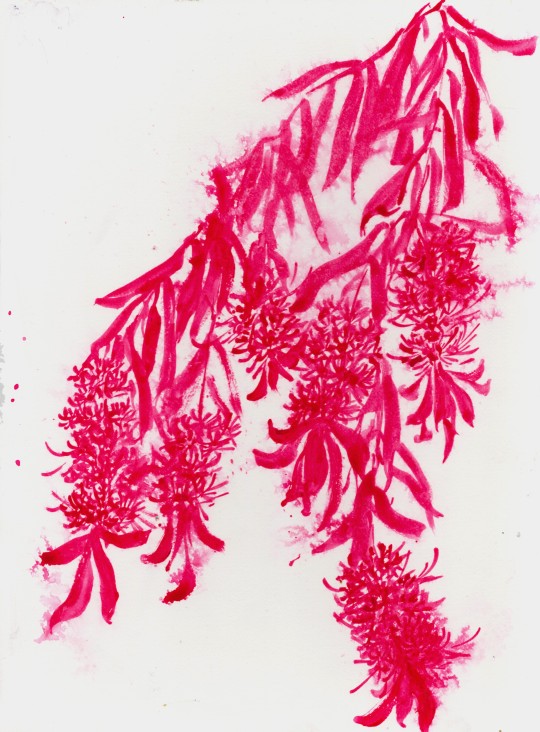
She Weeps For No Longer
Watercolor On Artboard
2022, 12"x 16"
Melaleuca viminalis, Weeping Bottlebrush Tree
#art#nature#painting#artists on tumblr#flowers#artist#floral#watercolor#minimalism#artwork#original art#bottlebrush#weeping bottlebrush#red bottlebrush#trees#australia#australian plants#melaleuca#red#flowering trees#plant#botany#plants
13 notes
·
View notes